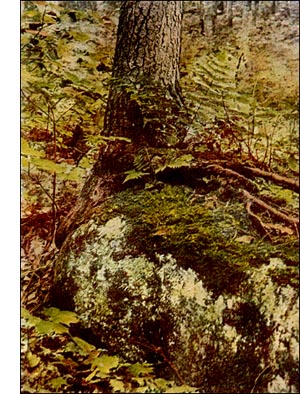Buxbaumia Aphylla Moss
 Buxbaumia aphylla, L.-See Plate XX.
Buxbaumia aphylla, L.-See Plate XX.Habit and habitat.-Small stemless plants growing on earth and decayed wood. Coloured patches of a peculiar green-black felt appear at first, and on this felt, which under the microscope is shown to be a web of minute-branched threads (protonema), young plants, minute and spherical, appear.
The moss has an annoying habit of disappearing from a station so that one cannot rely upon finding it the second time in the same locality. This sporadic habit and the scanty numbers of this moss invest its discovery with a charm known only to one who has collected it. The young sporecases appear early in September. During the winter they remain green and with the warm days of early spring begin growth again and the colour changes from green to brown. By the middle of March the plants are ready to disperse their spores.
Name.-The specific name aphylla is a compound of the Greek for; privative, without, and; a leaf.
History.-In 1712, J. C. Buxbaum, a German botanist, discovered the curious plant on which the genus was founded. He collected it near Astrakhan, on the banks of the Volga, and says, "I wished to make it into a new genus and name it after my father, but called to mind the fox, who was derided by the others, because he begged the grapes, not for himself, but for his sick mother." It was for a time regarded as a fungus; but in 1741 Johann Dillenius correctly referred it to the mosses. Schimdel made a careful study of it in 1758, and Linnaeus also wrote of it.
Plant (gametophyte).-Stemless, the male plants solitary in red-brown felt at the base of the female plant.
Leaves.-Extremely minute, oval or palm-shaped, soon disappearing; margin in shreds, or coarsely saw-toothed; cells, loose, colourless, long six-sided; leaves of the plant only two and without a shredded margin.
Habit of flowering.-Male and female flowers on separate plants (dioicous).
Veil (calyptra).-Conical.
Spore-case.-Inclined, boat-shaped, and depressed above, swollen below, smooth, greenishbrown; coat, firm, glossy, and thickened on the margin, rolling back at the mouth irregularly to form a crown-like border.
Pedicel (seta).-Rigid, erect, straight, 2 inch high, deep purple, rough; the base (vaginule) thick, covered with rusty hairs.
Lid (operculum).-Short, conic, obtuse, remaining for a time attached to the columella after separating at its margin.
Teeth (peristome).-The outer of short irregular teeth; the inner, a deeply plicate, funnel-shaped membrane.
Spores.-Very small, mature from April to September.
Distribution.-North Ameriica, Europe and Asia.